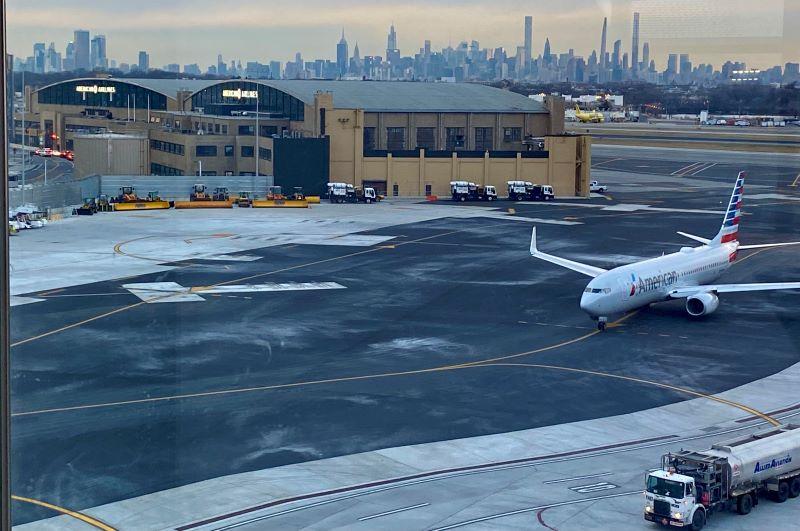
An American Airlines jet maneuvers on the surface at LaGuardia Airport in New York City.
The FAA has released a final rule that requires hub airports to implement organization-wide safety management systems (SMS), a regulation that affects 265 U.S. airports.
Released by the agency on Feb. 16, the final rule applies to Part 139 certificated airports that are classified as small, medium or large hubs based on passenger data; have a three-year rolling average of 100,000 or more arrivals and departures; or serve any international operation other than general aviation. Affected airports cover 90% of all U.S. passenger enplanements and include facilities with the largest number of commercial operations, the FAA says.
The rule requires that airports apply safety risk management in both movement and non-movement areas. A movement area is defined as the runways, taxiways and other areas of the airport used for taxiing, takeoff and landing of aircraft exclusive of loading ramps and aircraft parking areas, and areas that are managed by an air traffic control (ATC) tower. A non-movement area includes taxiways, aprons and other areas that are not under the control of ATC or exist at airports without an operating tower.
“The FAA has determined that there are unmitigated risks and safety gaps in the airport environment necessitating a systems approach to improve safety at Part 139 certificated airports,” the agency states in the rule.
“The increasing demands on the U.S. transportation system, including additional air traffic and surface operations and airport construction present a potential increased presence of operational hazards in the airfield environment,” the FAA explains. “However, many accidents and incidents that may be mitigated under SMS may not be shared outside the organization, especially in regard to the non-movement area, thus limiting FAA’s insight into the breadth or scale of near-miss and other types of potentially hazardous incidents. ... As the certificate holder best understands its own operating environment, it is in the best position to address many of its own safety issues.”
Depending on their classification and operations, airports have four to five years to fully implement SMS systems from the effective date of the regulation—60 days after its publication in the Federal Register or around late April. The FAA originally issued a notice of proposed rulemaking (NPRM) in October 2010, later updated, that would have required all Part 139 airports to establish SMS systems.
The release of the final SMS rule affecting airports coincides with recent near collisions of aircraft maneuvering at Daniel K. Inouye International Airport in Honolulu, JFK International Airport in New York and Austin-Bergstrom International Airport in Texas—incidents that are still being investigated and not necessarily attributable to the airports. On Feb. 10, five people were injured in a collision between a shuttle bus and a nearly empty American Airlines A321 that was being towed to a parking area at Los Angeles International Airport.
The airport rule also follows the FAA’s release in January of an NPRM that would require Part 135 charter operators, Part 91.147 air tour operators and aircraft manufacturers to implement SMS systems. Airlines have been required to have safety systems in place since 2018.
Associations representing the general aviation industry are focused on the latter NPRM, saying that a safety regulation developed for airlines must be scaled to the resources of smaller operators.
Commenting on airport rule, Doug Carr, National Business Aviation Association (NBAA) senior vice president for safety, security, sustainability and international affairs, said: “NBAA is reviewing the FAA’s final rule for airport SMS programs to understand opportunities for alignment between airport and operator requirements currently seeking industry feedback.” The comment deadline for the NPRM is April 11.
The National Air Transportation Association (NATA), which represents business aviation fixed-base operators, Part 135 carriers, fractional ownership companies and other aviation businesses, welcomed the airport final rule.
“As SMS positively impacts all aviation sectors, NATA supports the FAA’s efforts to enhance safety across the entire aviation ecosystem,” NATA President and CEO Curt Castagna said. “The final rule on airport SMS will increase interoperability between ground and air operation safety and risk management processes. For decades, NATA has been the industry leader in providing safety advocacy, awareness and education resources and will continue to explore the benefits of connectivity between airport and operator SMS programs.”
The FAA addresses scale in the airport regulation. “This rule does not require SMS implementation at small airports with fewer resources, where creating a SMS may be a larger proportional burden and may not be cost effective,” the agency states. The final rule includes an exception; if an airport qualifies for a safety system exclusively under the international services trigger, it may file a waiver request with the FAA to excuse it from the SMS requirement.
“To do so, it must certify that it does not host any operation by any tenant that is required to implement SMS under the applicable laws of its country of origin or any other governing jurisdiction,” the agency states. “For example, if international services at an airport are solely provided for operators engaged in general aviation operations, then—absent another trigger—the FAA will not require an airport to implement SMS.”

